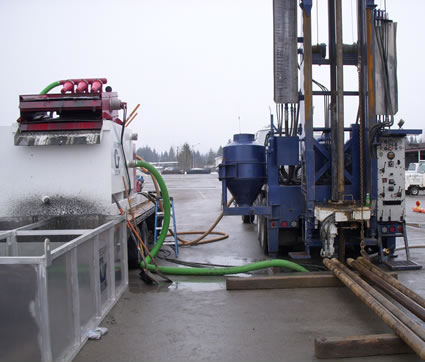
Geothermal
Heating and Cooling 101
Eliminate Your Heating and Cooling Bills with Planet-Friendly Geothermal Heating and Cooling
Geothermal technology uses the natural temperature of the earth to heat and cool commercial buildings and homes.
Dissipation Means Heat “Moves”
Ever notice how warm the air is in your bathroom after you take a shower? That’s because heat dissipates.
In other words, if one item is warmer than another, the heat “moves” to the cooler item to even out the temperature.
Since your shower water is warmer than the air around it, the heat naturally “moves” from the warmer water to the cooler air, evening out the temperature of both.
Using the Ground’s Warmth to Heat Your Home or Building
Think of the shower example again: heat moves from the warmer water to the cooler air. Geothermal heating works the same way.
For example, imagine it’s winter and your building or home doesn’t have a heating system. The air inside will be cool to cold, depending on where your building or home is located.
At the same time, the temperature of the ground around your building or home will be warmer in comparison at various depths, again, depending on your location.
Of course, you’re not going to heat your building or home by moving the warmer dirt from your property into your cooler building or home. Instead, you can have a geothermal heating system installed.
How Geothermal Heating Uses Natural Heat Dissipation
Geothermal heating systems have a series of underground pipes filled with liquid. The liquid acts as a go-between, moving the heat from the ground to your home or building.
Let’s return to our example of heating your building or home in the winter:
- The liquid moves through the underground pipes.
- The liquid gets warmed up by the heat in the ground.
- The warm liquid moves through the pipes into your building or home.
- A geothermal unit compresses the liquid’s warmth to a higher temperature.
- The geothermal unit sends the heat to your building or home through air circulation.
How Geothermal Cooling Uses Natural Heat Dissipation
When it comes to cooling your home or building in the summer, the process is simply reversed. Think of how a refrigerator works:
- Warmth in the fridge “moves” into liquid in circulating pipes.
- The liquid flows outside the fridge through the pipes.
- The warmth in the liquid dissipates outside the fridge.
- The room ends up warmer; the fridge ends up cooler.
Let’s use your building or home in the summer as another example:
- The warmth in the air in your building or house “moves” into the geothermal heating system liquid.
- The liquid flows outside your building house through the system’s pipes.
- The warmth in the liquid dissipates into the relatively cool ground.
- The ground ends up warmer; your building or house ends up cooler.
Natural, Efficient, and Endorsed
Geothermal heating and cooling uses the natural process of heat dissipation as a planet-friendly heating and cooling solution.
At the same time, geothermal heating and cooling is highly efficient. A geothermal system costs less to operate than a natural gas, oil, or electric heating system, even in the winter. With savings of up to 60% compared to conventional systems, the initial cost of a geothermal system can be quickly regained.
Geothermal technology is endorsed by the Department of Energy and the Environmental Protection Agency (EPA).
Special Licensing Requirements for Geothermal Drillers and Installers
When getting a geothermal heating and cooling system installed for your home or building, be aware that special licensing is required for geothermal drilling and installation.
The Gregory Drilling team is both experienced and specially licensed to drill and install geothermal heating and cooling systems.
Contact us today to eliminate your heating and cooling bills with your own long-lasting geothermal system.

